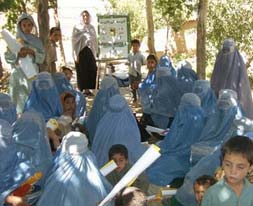Opposition within Afghanistan to girls’ participation in education predates the Taliban. Historically, education for girls was rare in rural Afghanistan and almost exclusively confined to the capital. In 1919 King Amanullah seized the Afghan throne and began a rapid development of the country’s secular education system, with a particular focus on expanding education for women. During this period shortly following independence from Britain, women and girls were encouraged in their scholarly pursuits. This shift, however, directly threatened the centuries-old practice of traditional male-oriented madrassa (religious) education among many of the ethnic tribes in Afghanistan. Amanullah’s experiment with a secular approach to education, along with other reforms prohibiting polygamy and bride price — the provision of money to the wife’s family upon marriage — aroused protest from the country’s religious establishment, who eventually supported the overthrow of the king.
Nadir Shah, who took power following Amanullah, was more cautious in his attempt to introduce educational opportunities for women. Nevertheless, over the course of the twentieth century, and in particular during King Mohammed Zahir’s long reign between 1933 and 1973, Afghanistan’s education system steadily expanded even as it continued to be influenced by demands from the country’s conservative cultural and religious authorities. By the 1970s, women made up over 60 percent of the 10,000 students who studied at Kabul University.
The rise of the Soviet-backed People’s Democratic Party of Afghanistan in 1978 brought large-scale literacy programs for men and women, again alongside the abolition of bride price and other reforms beneficial to women. During this period leading up the Soviet occupation of Afghanistan, reforms in areas such as education stirred resentment among religious and tribal leaders in the rural areas. Although full implementation of these reforms were limited by political exigencies, women were able to experience expanded access to education and also the opportunity to actively participate as university faculty staff.
During the Soviet occupation from 1979 to 1989, Afghans lived through a devastating war fueled by external forces and funding from multiple countries, among them the United States, Iran, Saudi Arabia, Pakistan, and China. Islamic militants, or Mujahideen, thrived in rural areas and constructed their own revolutionary army with the goal of overturning all socialist policies such as those governing women’s rights in general, and access education in particular.
With the fall of the Communist government in 1992, the country was divided among warring factions, many of them religiously inspired Mujahideen groups ideologically opposed to modern education and to education for girls. Millions of Afghans, particularly the educated, emigrated to other countries. Many of the schools not destroyed by war were closed due to lack of security, the lack of teachers and teaching material, or simply because of dire poverty.
Education under the Taliban went from bad to worse. The Taliban focused solely on religious studies for boys and denied nearly all girls the right to attend school. During the Taliban’s rule, only about 3 per cent of girls received some form of primary education. The prohibition of female education, coupled with the cultural mandate that women receive their health care from female health care providers, resulted in a vulnerable population receiving care from poorly-educated providers.
Twenty-three years of war have destroyed the infrastructure of the education system and further increased the illiteracy rate in Afghanistan. Since 2001, the participation of children and adults in education has improved dramatically and there is great demand. Afghanistan has one of the youngest populations on the planet. Unexpectedly large numbers showed up when schools reopened in 2002, and enrollments have increased every year since, with the Ministry of Education reporting that 5.2 million students were enrolled in grades one through twelve in 2005. This includes an estimated 1.82-1.95 million girls and women. An additional 55,500-57,000 people, including 4,000-5,000 girls and women, were enrolled in vocational, Islamic, and teacher education programs, and 1.24 million people were enrolled in non-formal education programs. These numbers represent a remarkable improvement from the Taliban era. More Afghan children are in school today than at any other period in Afghanistan’s history.
In 2003, in response to the lack of educational opportunities in Afghanistan for the general population and especially for females, the United States Agency for International Development funded the Afghanistan Primary Education Program (APEP). APEP offers emergency access to accelerated elementary education for out-of-school youth between 10 and 18 years of age, focusing on females. Between 2003 and 2005, APEP supported accelerated learning programs for 170,000 over-age youth in more than 3,000 villages in Afghanistan.
Located at Kabul University, the Women’s Teacher Training Institute opened in September 2004. The institute is currently operating programs that aim to teach basic literacy to Afghan women in rural areas and to reduce maternal and child mortality.
Despite numerous positive steps forward in education for Afghan women and girls, persistent violent attacks on schools by resurgent Taliban and other forces continue to force some schools to close.
In a statement released in June 2006, Ret. U.S. Gen. Barry McCaffrey stressed the comparative superiority of the Taliban’s equipment and tactics to those of the NATO-trained Afghan National Army (ANA). “They are brutalizing the population,” wrote McCaffrey of the Taliban, “and they are now conducting a summer-fall campaign to knock NATO out of the war, capture the provincial capital of Kandahar, isolate the Americans, stop the developing Afghan educational system, stop the liberation of women, and penetrate the new police force and ANA.”
- Previous: Introduction
- Next: Politics



